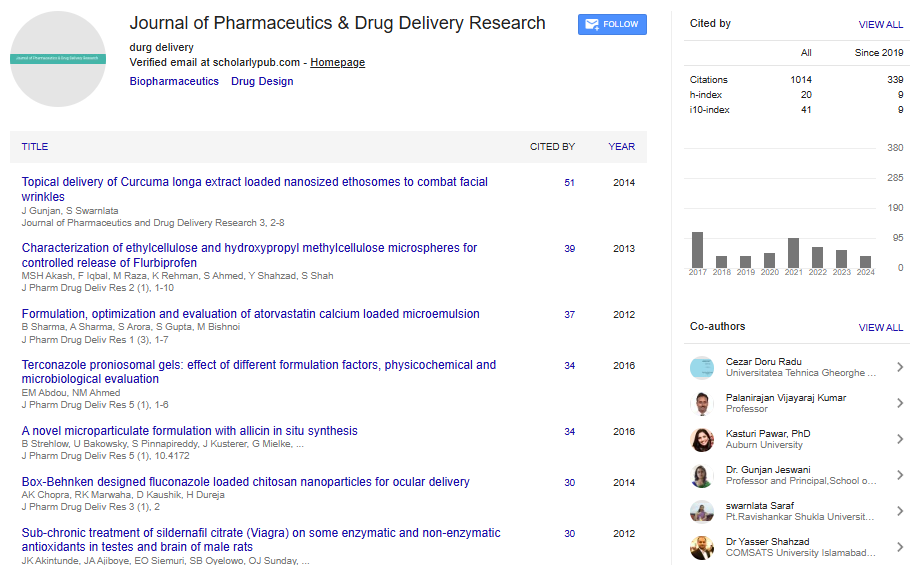Perspective, J Pharm Drug Deliv Res Vol: 13 Issue: 6
Bioavailability: It’s Role in Pharmacology and Drug Development
Yong Sung*
1Department of Pharmacy, Dankook University, Yongin, South Korea
*Corresponding Author: Yong Sung,
Department of Pharmacy, Dankook
University, Yongin, South Korea
E-mail: sun.yo@gmail.com
Received date: 28 October, 2024, Manuscript No. JPDDR-24-154065;
Editor assigned date: 30 October, 2024, PreQC No. JPDDR-24-154065 (PQ);
Reviewed date: 13 November, 2024, QC No. JPDDR-24-154065;
Revised date: 20 November, 2024, Manuscript No. JPDDR-24-154065 (R);
Published date: 29 November, 2024, DOI: 10.4172/2325-9604.1000307
Citation: Sung Y (2024) Bioavailability: It’s Role in Pharmacology and Drug Development. J Pharm Drug Deliv Res 13:6.
Description
Bioavailability is a significant principle in pharmacology and pharmaceutics, representing the proportion of a drug that enters the bloodstream and becomes available to produce its therapeutic effect. It plays a central role in drug design, formulation and administration, influencing a medication's efficacy, safety and dosing regimen. Bioavailability refers to the fraction of an administered drug dose that reaches the systemic circulation in an original condition. For Intravenous (IV) administration, bioavailability is considered 100% since the drug directly enters the bloodstream. However, for other paths such as oral, subcutaneous or transdermal administration, the bioavailability is frequently less than 100% due to absorption barriers and initial phase metabolism. There are two types of bioavailability: Absolute and relative bioavailability. Absolute bioavailability evaluates a drug's bioavailability when supplied non-intravenously to when administered intravenously. Relative bioavailability compares the bioavailability for two different formulations of the same medicine.
Factors influencing bioavailability
The bioavailability of a drug is influenced by a wide range of physiological, physicochemical and formulation-related factors.
Physiological factors: The drug's absorption can be affected by pH levels, motility and the presence of food in the Gastrointestinal (GI) tract. Drugs metabolized extensively by the liver before entering systemic circulation exhibit reduced bioavailability. Enzymes in the GI tract can degrade certain drugs and reducing their availability.
Physicochemical properties of the drug: Drugs must dissolve in bodily fluids to be absorbed; poorly soluble drugs generally have low bioavailability. Drugs require the biological membranes to enter the bloodstream. Lipophilic drugs generally affect more easily than hydrophilic compounds. Drugs are dangerous in gastric acid or prone to enzymatic degradation may have compromised bioavailability.
Formulation factors: Additives in the formulation can enhance or inhibit drug dissolution and absorption. Smaller particles have a higher surface area, which result in simpler dissolve and absorption. Controlled-release formulations can affect the process and level of medication absorption.
Role of bioavailability in drug development
Bioavailability is a fundamental of drug development, controlling behaviors at all stages: Bioavailability studies in experimental models improve the selection of potential medication compounds for future development. Optimizing bioavailability is a main objective in the design of drug formulations, ensuring effective and patient products. Pharmacokinetic studies in human subjects assess the bioavailability of investigational drugs, informing dosage recommendations. Regulatory agencies evaluate bioavailability data to ensure the safety and efficacy of new drugs before providing regulatory authorization.
Emerging trends in bioavailability
The field of bioavailability is evolving with advances in technology and science. Emerging trends include: Nanoparticles, nanoemulsions and nanosuspensions are being used to improve the solubility and absorption of medications that serve as bioavailable. 3D printing technologies allow for the creation of customized drug formulations with precise bioavailability profiles. Artificial Intelligence (AI) is being utilized to indicate bioavailability based on chemical structure and optimize formulation techniques. For complex biologics, improving bioavailability involves overcoming barriers such as enzymatic degradation and poor membrane permeability.
Mechanisms to enhancing bioavailability
Pharmaceutical scientists employ various methods to improve bioavailability: Reducing the particle size of drugs to improve dissolution. Lipid-based delivery systems such as liposomes and Self- Emulsifying Drug Delivery Systems (SEDDS), enhance solubility and permeability. Optimize the frequency and position of medication release to improve absorption. Pro-drugs are chemically modified versions of the active drug that are better absorbed and later converted to their active form in the body. Substances that temporarily increase the permeability of biological membranes, such as bile salts or surfactants, can improve drug absorption. For drugs with poor oral bioavailability, alternative routes such as sublingual, transdermal or inhalation can be explored to bypass absorption barriers.
Clinical implications of bioavailability
Bioavailability is essential in determining a drug's dosing regimen, therapeutic effectiveness and safety. It has several clinical implications: Drugs with low bioavailability may require higher doses to achieve therapeutic levels. However, this must be balanced against the risk of side effects or toxicity. The bioavailability of generic drugs is compared to recognized pharmaceuticals to ensure therapeutic equivalence. Regulatory agencies mandate bioequivalence studies to confirm that the generic drug performs similarly to the innovator product. Individual variability in bioavailability highlights the need for personalized dosing techniques. Genetic variables regulating metabolism can have a major impact on drug bioavailability.
 Spanish
Spanish  Chinese
Chinese  Russian
Russian  German
German  French
French  Japanese
Japanese  Portuguese
Portuguese  Hindi
Hindi 
